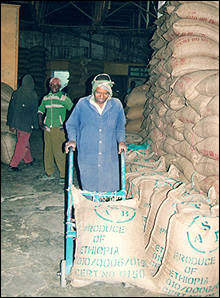 NEW EFFORT FOR SUSTAINED DEVELOPMENT- AGRICULTURE NEW EFFORT FOR SUSTAINED DEVELOPMENT- AGRICULTURE |
Agriculture remains the backbone of the Ethiopian economy. Typically, it is the largest source of employment, more than 80 percent of the population are dependent for its livelihood on farming. The labour intensive character of the sector reduces its contribution to the Gross Domestic product, but it nevertheless ranges between 40 and 60 percent.
In addition, the agricultural sector generates about 90 percent of the export earnings and supplies about 70 percent of the country's raw material requirement for large and medium sized industries that are agro-based.

In pre 1975 Ethiopia, land tenure was highly complicated and diverse not only from region to region but even within the same region. Land and agricultural production systems up to 1975 could be classified into tributary, feudal and capitalist tenure and production systems.
The March 1975 land reform legislation, which was issued by the Dergue regime, had the following main features. It abolished all forms of private ownership of land and put land under state control; individual farmers were allowed to cultivate up to 10 hectares of land; entitled peasants to usufruct right over land, a right they could not transfer by sale, lease, or mortgage.
Small-scale farms account for 95 percent of the total area under crop production and for more than 90 percent of the total agricultural output. Moreover, small-scale farms produce 94 percent of food crop and 98 percent of coffee while the remaining 6 percent of the food crop and 2 percent of the coffee production is generated from modern farms.
Land and water, the principal natural resources used in agriculture, are very unevenly distributed among different regions. The are also wide differences in the quality of land, the climate and the size and structure of land holdings add to the diversity of growing conditions.
Ethiopia annually gets more than 112 billion cubic meter water resources, from its rivers and the bottom of the earth, which can irrigate and change 2.8 million hectares of land into verdant fields. But from these water resources, the farmers to irrigate 70,000 hectares of land use only inconsiderable amount of water resources on traditional basis. Most agricultural production depends on rainfall.
| The implementation of the new market oriented economic policy has steadily improved the overall policy environment. In the agricultural sector, producer co-operatives have been dissolved, private commercial farms are being encouraged, public investment in state farms has been drastically reduced, all compulsory food grain quotas have been abolished and free food grain trade has been restored.
The government of Ethiopia, recognising the importance of the Crop Development Sub-Sector has accorded the highest priority to the development of peasant agriculture which has been facing complex problems. The main objective with regard to this sub-sector is to achieve accelerated and sustainable growth in crop production and productivity.
The development strategy adopted in August 1992 set the country's economic development strategy to be Agricultural Development Led-Industrialisation, a strategy which aims at increasing food production and overall economic growth. It is foreseen that 70 percent of the incremental production would came from crop intensification and 30 percent from expansion of land under cultivation. In light of the ADLI strategy, the government of Ethiopia has initiated a five-year agricultural development program with the objective of closing the food gap on a medium term basis.
Regarding land, the government has passed a lease holding policy for urban lands to be allocated through auctioning. The initial price for the auction, the lease period and other conditionalities are to be specified by regional administrations. As an essential and scarce resource for any investment activity, the distribution of land is yet far from satisfactory to private agents venturing on new investment.
Moreover, no clear guideline has been issued concerning the use of rural land; until now regional administrations have been giving unoccupied land, not under farmers' utilization, to private investors at their own discretion.
 In search of fortune In search of fortune |
Dinsho Group of Companies is a multi-sectoral company which is mainly involved in the agricultural sector.
Dinsho Agro-Industry PLC is a company under Dinsho Trading, which undertakes in different ventures in the agricultural sector mainly in the Oromiya Regional State.
Mr. Dubale Jale, Chairman and CEO of Dinsho Companies, says, "The largest activity we are engaged in, is the distribution of agricultural inputs, and we do have reasons to do so, about 85 percent of the population is involved in agriculture." He adds, "We also reproduce selective seeds in our farms to distribute to the farmers".
The company is determined to participate in every sector and foreign investors or partners are most welcome. Mr. Dubale confirms "We are involved in some joint ventures with some foreign investors. We have already penetrated many important markets in terms of demand and supply. Therefore, foreign investors are very interested with us, and our interaction with foreign companies is very interesting."
Dinsho works jointly with some foreign known companies. Mr. Dubale discloses "Dinsho is working closely with BASF, one of the largest company in the world.". |

